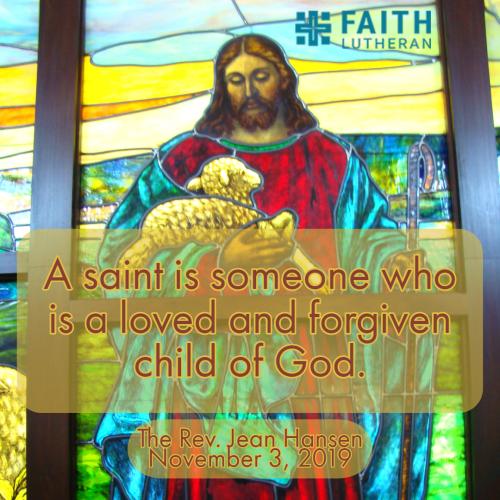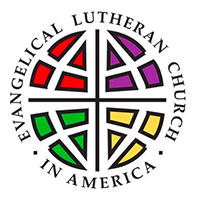
Stained-Glass Saints…and More
Nov 03, 2019
Sermon 11-3-19
All Saints’ Sunday
Luke 6:20-31
Pastor Jean M. Hansen
Stained-Glass Saints…and More
On this All Saints’ Sunday, it’s logical for us to consider this question – what is a saint? Look around, you’ll see saints – living ones and, also, saints depicted in the stained-glass windows.
A few weeks ago, on a Saturday morning, I came into the sanctuary with some youth who were about to be trained as acolytes. The room was dim, but the sun was shining, so the windows looked vivid. We took a moment to really look at them, to notice the nameplates in the window wells which identify each Biblical or historical figure, and to look for the symbol that gives a clue to their identity.
For example, the crown in one helps us to know that’s King David and the rose-like symbol in another indicates it’s Martin Luther. The young people had not realized that each window tells a saint’s story.
That reminds me of a story told by a Methodist pastor about a man who was walking through a beautiful church with his 4-year-old son. As they walked, the young boy looked around. He stopped and was curious about the stained-glass windows that looked so beautiful with their bright colors. As he looked at the windows, he aside, “Who are all the people in the windows, Daddy?” “They are saints,” said the father. So, you can guess what the next question was: “What are saints?”
The father was stuck; how was he going to explain saints to a 4-year-old boy? As his son was still looking up at the windows and the father was still wondering how he would explain who saints are, the child suddenly shouted out, “I know who saints are, daddy! They are the people that the light shines through!” (1)
That’s a good definition since a saint is a person of faith who is used by God to share God’s word, will, and ways. A saint conveys God’s grace.
Last Sunday, we reflected on the truth that we all have equal standing with God. As we read in Romans 3: “There is no distinction, since all have sinned and fall short of the glory of God; they are now justified by his grace as a gift, through the redemption that is in Christ Jesus….” (Romans 3:22-24) Another way to say that is this; we are all saints in God’s sight through Jesus.
It’s not how we live that makes us saints, but how Jesus lived for us, died for us and rose for us. Being the loved and forgiven children of God makes us, and a lot of other people too, saints.
Another way to describe saints is as those blessed by God. However, just as a saint can be an ordinary, not especially saintly-acting person, those whom Jesus calls blessed may seem not to be blessed at all.
That’s obvious in today’s Gospel lesson, which is Luke’s version of the Sermon on the Mount found in the Gospel of Matthew, chapters 5-7. In it, Jesus is not speaking from a mountain, but on the plain; the message being that he’s “down there” with the people. He not only speaks of who is blessed, but who is not blessed.
The blessed, surprisingly, are those who are poor, hungry, weeping and all who are hated, excluded and defamed due to their faith. Those to whom Jesus says, “woe to you,” are the rich, the satiated, the happy, and those who are praised by others. Now, that’s a bit difficult to grasp, especially since most of us are in group two rather than group one.
Most scholars say that those who struggle with poverty, hunger, and grief are blessed because their vulnerability makes it necessary for them to trust God, and trusting God fully leads to contentment in this life and celebration in the next. In contrast, those who are comfortable receive a word of woe because they tend to trust possessions, people, power (presumed security) more than they trust God, which means they may miss out on true contentment.
In either case, the path to contentment is two-fold. It’s a journey of trusting God and of living out our sainthood. Jesus spells it out: “Love your enemies, do good to those who hate you, bless those who curse you, pray for those who abuse you. If anyone strikes you on the cheek, offer the other also; and from anyone who takes away your coat do not withhold even your shirt. Give to everyone who begs from you; and if anyone takes away your goods, do not ask for them again. Do to others as you would have them do to you.”
How many times have we heard or read those words, and we still shake our heads and ask, “Did Jesus really mean that?” I’d say yes, he meant that we are to go the extra mile, do that which can only be done by the power of the Holy Spirit, turn the usual ways of the world upside down. If we strive to do all that, then another definition of a saint fits: a saint is someone whose life makes it easier to believe in God.
No doubt, we all know people like that, some who are living saints, and others who have gone before us. Remember the story of the stained-glass saints? Who are the people in your life who the light shines through?
The same pastor who told that story, whose name happens to be Kenneth Sauer, although he’s not the Bishop Sauer who many of you know, writes about a pastor, named Bob, who was raised in a family that did not attend church, his father had a reputation for “hardness.”
Bob delivered newspapers as a boy back in the days when that was a job for young people, many of whom made the deliveries on their bikes before going to school, or as soon as school was dismissed. Those paper deliverers got to know their customers because they would go to their homes and collect the payment for the newspaper.
It turned out that one of the customers on Bob’s route was a Methodist minister, and one day when Bob came to collect for the newspaper, the minister said, “You know, Bob, I was wondering … I’m the pastor of the Methodist church down the street. We do not have anyone to hand out bulletins on Sunday mornings. I wonder if you’d be willing to come and hand out bulletins?”
Bob was astonished. He had never been to church, let alone handed out bulletins, but he was honored that this man had asked him to do this and decided to give it a shot. It turned out to be a changing point in Bob’s life. He met and was befriended by the saints of that church, who loved him, took him under their wing, became his family, and taught him about Jesus. Bob ended up going to seminary, and from there had a lifelong ministry of loving people into God’s kingdom. (2)
Now, while that’s an old-fashioned type of story, the aspect of it that still applies is that anyone of us could be the person who shines the light of God’s love on another person’s life. It may or may not mean that they show up in a church, although I certainly hope that if you can, you encourage them to do so.
Still, your living out your faith, going the extra mile, being a source of hope and truth, may be the thing that makes a difference in a time when so much that we encounter in person or through media is just the opposite of what Jesus asked of us.
Remember, a saint is not perfect; a saint is someone who is a loved and forgiven child of God, who is blessed by the opportunity to trust God above all else and whose life makes it easier to believe in God. That is us and can be us more and more. Today we give thanks for all the saints. AMEN
(1) “What Makes A Saint?” by Kenneth Sauer, United Methodist, Luke 6:20-31, Jan. 3, 2014, www.sermoncentral.com
(2) Same as #1






